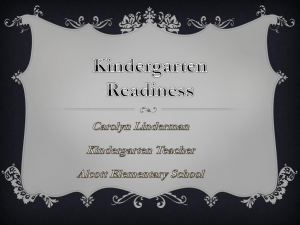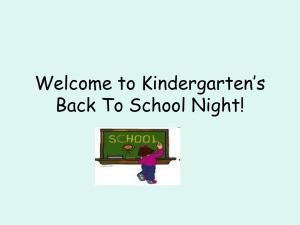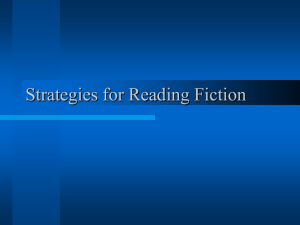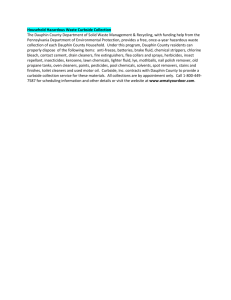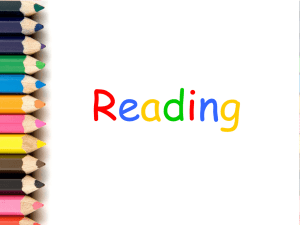Language Arts Curriculum - Lower Dauphin School District
advertisement
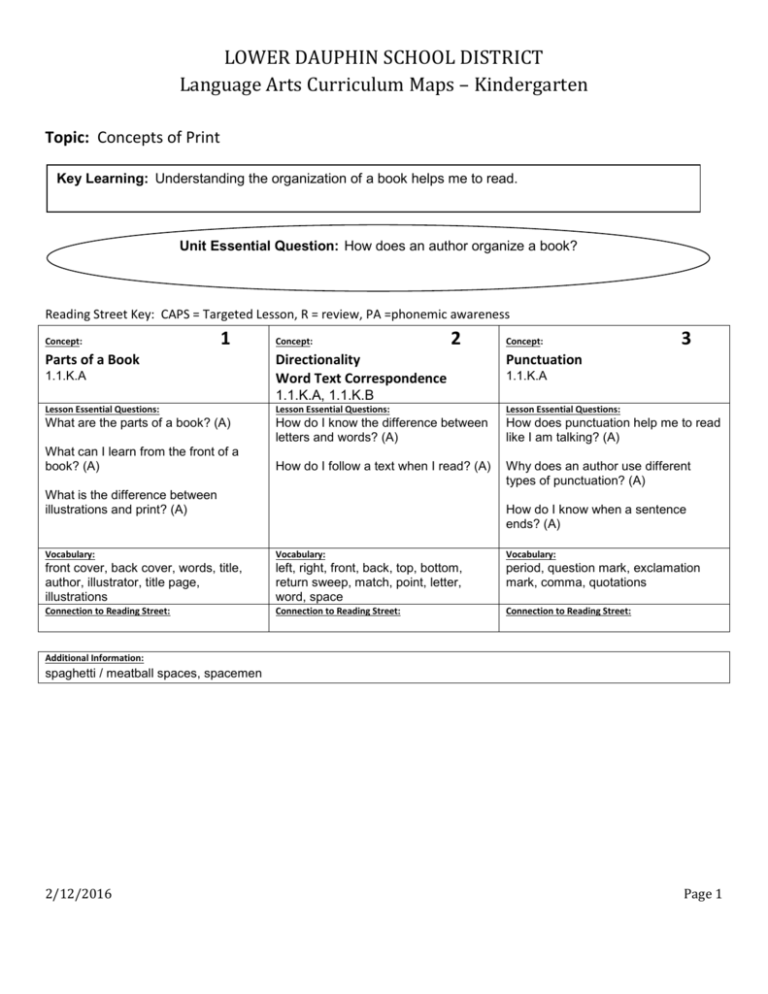
LOWER DAUPHIN SCHOOL DISTRICT Language Arts Curriculum Maps – Kindergarten Topic: Concepts of Print Key Learning: Understanding the organization of a book helps me to read. Unit Essential Question: How does an author organize a book? Reading Street Key: CAPS = Targeted Lesson, R = review, PA =phonemic awareness Concept: 1 Parts of a Book 1.1.K.A Concept: 2 Directionality Word Text Correspondence Concept: 3 Punctuation 1.1.K.A 1.1.K.A, 1.1.K.B Lesson Essential Questions: Lesson Essential Questions: Lesson Essential Questions: What are the parts of a book? (A) How do I know the difference between letters and words? (A) How does punctuation help me to read like I am talking? (A) How do I follow a text when I read? (A) Why does an author use different types of punctuation? (A) What can I learn from the front of a book? (A) What is the difference between illustrations and print? (A) How do I know when a sentence ends? (A) Vocabulary: Vocabulary: Vocabulary: front cover, back cover, words, title, author, illustrator, title page, illustrations left, right, front, back, top, bottom, return sweep, match, point, letter, word, space period, question mark, exclamation mark, comma, quotations Connection to Reading Street: Connection to Reading Street: Connection to Reading Street: Additional Information: spaghetti / meatball spaces, spacemen 2/12/2016 Page 1 LOWER DAUPHIN SCHOOL DISTRICT Language Arts Curriculum Maps – Kindergarten Topic: Phonological Awareness Key Learning: Words can be taken apart and put back together to help me learn. Unit Essential Question: How will listening to different sounds help me to learn? Reading Street Key: CAPS = Targeted Lesson, R = review, PA =phonemic awareness Concept: 1 Concept: 2 Concept: 3 Environmental Sounds Rhyming Concept of Word 1.1.K.C 1.1.K.C, 1.1.K.B 1.1.K.C Lesson Essential Questions: Lesson Essential Questions: Lesson Essential Questions: What sounds do I hear around me? (A) How do I know when words rhyme? (A) How do I know the difference between letters, words and sentences? (A) How do create sounds around me? (A) How can I make words rhyme? (A) How do I follow a text when I read? (A) Vocabulary: Vocabulary: Vocabulary: What sounds do I hear around me? (A) Rhyme, identify, produce Letter, word, sentence Letters make words. Words make sentences. How do I create sounds around me? (A) Connection to Reading Street: Rhyming words sound the same at the end. Connection to Reading Street: Connection to Reading Street: Unit 1: 2/12/2016 Page 2 LOWER DAUPHIN SCHOOL DISTRICT Language Arts Curriculum Maps – Kindergarten Phonological Awareness Map (continued) Concept: 4 Concept: 5 Concept: 6 Sound Identification Syllables Onset Rime 1.1.K.C 1.1.K.E 1.1.K.E Lesson Essential Questions: Lesson Essential Questions: Lesson Essential Questions: How does saying the sounds in words help me read and write? (A) How do I break a word into parts? (A) How do I break a word into parts? (A) How do I blend sounds to say a word? (A) How do I blend sounds to say a word? (A) Vocabulary: Vocabulary: Vocabulary: Initial, final, medial, sound DIBELS ISF Benchmarks: Fall: 8-24 Winter: 25-41 parts, break, syllables, sound parts, break, onset, rime, chunk Connection to Reading Street: Connection to Reading Street: Connection to Reading Street: Concept: 7 Concept: 8 Concept: 9 Segmenting Phonemes Blending Substituting Phonemes 1.1.K.E 1.1.K.C, 1.1.K.F 1.1.K.E Lesson Essential Questions: Lesson Essential Questions: Lesson Essential Questions: How do I break a word into parts? (A) How do I blend sounds to say a word? (A) How does moving a sound change a word? (A) How do I blend sounds to read a word? (A) How does deleting a sound change a word? (A) Vocabulary: Vocabulary: Vocabulary: stretch, phoneme, segment, sounds DIBELS PSF Benchmarks: Winter: 18-35 Spring: 35-49 blend, sounds, phoneme DIBELS Benchmarks: Fall: NWF 13-25 Winter: NWF , WRC 1-2, Spring: NWF 25-44, WRC 3-5 delete, change, sound, phoneme, move Connection to Reading Street: Connection to Reading Street: Connection to Reading Street: How does hearing and saying each sound help me to read and write? (A) Additional Information: District Benchmarks 2/12/2016 Page 3 LOWER DAUPHIN SCHOOL DISTRICT Language Arts Curriculum Maps – Kindergarten Topic: Comprehension – Shared Reading and Teacher Modeling Key Learning: I can learn by listening to my teacher model and talk during shared reading. Unit Essential Question: How does listening to my teacher model and talk while reading help me understand? Reading Street Key: CAPS = Targeted Lesson, R = review, PA =phonemic awareness Concept: 1 Concept: 2 Concept: 3 Previewing Predicting Visualizing 1.1.K.K, 1.1.K.L 1.3.K.B 1.1.K.K. Lesson Essential Questions: Lesson Essential Questions: Lesson Essential Questions: How can the title and the cover of a book help me think about the story? (A) How can I use the title and the cover to make a prediction? (A) How does the title create a picture in my mind? (A) How do I use the illustrations to help me make predictions? (A) How do the illustrations create pictures in my mind? (A) How do the illustrations create the story? (A) How do the words create pictures in my mind? (A) Vocabulary: Vocabulary: Vocabulary: preview, title, cover, illustrations, picture walk and talk, model using a variety of text including poetry title, cover, prediction, illustrations, stop and think, look at the pictures, model using a variety of text including poetry title, picture, words, model using variety of text including poetry Connection to Reading Street: Connection to Reading Street: Connection to Reading Street: 2/12/2016 Page 4 LOWER DAUPHIN SCHOOL DISTRICT Language Arts Curriculum Maps – Kindergarten Comprehension – Shared Reading and Teacher Modeling Map (continued) Concept: 4 Concept: 5 Concept: 6 Making Connections Retelling Vocabulary 1.3.K.A 1.2.K.A, 1.2.K.B 1.1.K.K, 1.1.K.L, 1.1.K.M., 1.1.K.N. Lesson Essential Questions: Lesson Essential Questions: Lesson Essential Questions: What does the story make me think about? (A) How should I begin to retell this story? (A) Why is it important to story vocabulary when I talk about the story? (A) How can I start at the beginning and tell what happened in the story? (A) How do I connect use new vocabulary? (A) How can I use characters, names, and important details in my retelling? (A) What resources can be used to build my vocabulary? (A) How do I remember the whole story? (A) Vocabulary: Vocabulary: Vocabulary: model using a variety of text including poetry beginning, end, before/after, characters, details, model using a variety of text including poetry, prompts: what happens next, tell me more vocabulary, resources (word wall, reference materials, text), model Connection to Reading Street: Connection to Reading Street: Connection to Reading Street: (mostly Vocab) using a variety of text including poetry Additional Information: big books, text 2/12/2016 Page 5 LOWER DAUPHIN SCHOOL DISTRICT Language Arts Curriculum Maps – Kindergarten Topic: Comprehension – Guided Reading Key Learning: Language, pictures, and print have meaning and give me information. Unit Essential Question: How do I get information from what I read? Reading Street Key: CAPS = Targeted Lesson, R = review, PA =phonemic awareness Concept: 1 Concept: 2 Concept: 3 Word Solving in Context Strategies Critical Reading 1.1.K.H 1.2.K.A, 1.3.K.A 1.1.K.A, 1.2.K.A Lesson Essential Questions: Lesson Essential Questions: Lesson Essential Questions: How can I use the picture to help me when I read? (A) What do I do before I read? (A) How do pay attention to pattern when I am reading? (A) What do I do while I am reading? (A) How can I use the beginning of a word to help me when I read? (A) How do I know what I read? (A) How do I remember and tell what I read? (A) Vocabulary: Vocabulary: Vocabulary: picture, beginning, word, tricky, unknown, self-correct, Questioning: Does this make sense? Does this look right? Does this sound right? pretell – sharing steps in a process (lining up for lunch, brushing your teeth), predict, preview, retell (refer to Comprehension-Shared Reading Map for specific instructional information on these strategies) retell, details, pictures, sequence, pattern (of text), change in pattern, character, vocabulary specific to text Connection to Reading Street: Connection to Reading Street: (monitoring) Connection to Reading Street: See also Phonological Awareness Map Comprehension – Guided Reading Map (continued) Concept: 4 Fluency 1.1.K.J 2/12/2016 Page 6 LOWER DAUPHIN SCHOOL DISTRICT Language Arts Curriculum Maps – Kindergarten Lesson Essential Questions: What does reading sound like? (A) Vocabulary: talking, letter naming fluency Connection to Reading Street: addressed in all units Additional Information: Leveled text, strategy 2/12/2016 Page 7 LOWER DAUPHIN SCHOOL DISTRICT Language Arts Curriculum Maps – Kindergarten Topic: Phonics and Word Study Key Learning: Automatic recognition of letters and sounds helps me to read and write. Unit Essential Question: How does knowing letters and sounds help me to be a better reader and writer? Reading Street Key: CAPS = Targeted Lesson, R = review, PA =phonemic awareness Concept: Environmental Print 1.1.K.C 1 Concept: 2 Letter Name (Alphabetic Principle) 3 Concept: Letter Sound Relationships 1.1.K.C 1.1.K.C Lesson Essential Questions: Lesson Essential Questions: Lesson Essential Questions: What can I read in my world? (A) Why is it important for me to know letter names? (A) Why is it important for me to know letter sounds? (A) Why is it important to quickly name letters? (A) How do I use letter sounds to read and write? (A) Why is it important to put letters in order? (A) How does saying the sounds quickly help me to read? (A) How do I blend sounds to read a word? (A) Vocabulary: Vocabulary: Vocabulary: print letter, alphabet, fluency (with letter naming), alphabet arc, DIBELS LNF Benchmarks Fall: 8-34 Winter: 27-40 Spring: 40-49 letter, sound, blend Connection to Reading Street: Connection to Reading Street: Connection to Reading Street: 2/12/2016 Page 8 LOWER DAUPHIN SCHOOL DISTRICT Language Arts Curriculum Maps – Kindergarten Phonics & Word Study Map (continued) 4 Concept: Letter Formation Concept: 5 6 Concept: Word Families High Frequency Words/Sight (Rime Chunks with Short Vowels) Words 1.1.K.C 1.1.K.C, 1.3.K.C 1.1.K.C Lesson Essential Questions: Lesson Essential Questions: Lesson Essential Questions: How does knowing the shapes of letters help me to read and write letters? (A) How are words within word families the same? (A) Why are sight words important? (A) How do I write letters? (A) Why is it important for me to write my words? (A) What happens when I change the first letter of a word in a word family? (A) How do sight words help me to read and write? (A) Vocabulary: Vocabulary: Vocabulary: top, bottom, straight lines, big line, short line, big curve, little curve, upper case, lower case, shapes, form, spell, name Utilize multi-sensory activities to support and practice letter formation. chunk, word families, core chunks (at, -an, -it, -in, -ot, -et, -en,-up, -un) word walls, sight words Connection to Reading Street: Connection to Reading Street: Concept: *see grade level sight word assessment Connection to Reading Street: 6 Using References 1.1.K.C Lesson Essential Questions: What helps me write letters and words? (A) Vocabulary: letter/sound chart, alphabet strip, name chart, name tag, alphabet arc, word wall, Quick Word Book Connection to Reading Street: Additional Information: alphabet arc, word wall, alphabet strip, letter charts for fluency practice, letter/sound charts, Handwriting Without Tears materials 2/12/2016 Page 9 LOWER DAUPHIN SCHOOL DISTRICT Language Arts Curriculum Maps – Kindergarten Instruction with phonological awareness is a precursor to word study. Instruction of word families occurs at the phonics – print level. 2/12/2016 Page 10 LOWER DAUPHIN SCHOOL DISTRICT Language Arts Curriculum Maps – Kindergarten Topic: Analyzing and Interpreting Fiction Key Learning: Fiction stories are organized with a character, setting, problem and order of events. Unit Essential Question: How does an author organize a fiction text? Reading Street Key: CAPS = Targeted Lesson, R = review, PA =phonemic awareness Concept: 1 Concept: Story Elements Literary Devices 1.3.K.A, 1.3.K.B 1.1.K.D Lesson Essential Questions: Lesson Essential Questions: What are the parts of a fiction text? (A) How does rhyme make a text predictable? (A) How can knowing the parts of a fiction text help me understand what I read? (A) How can I hear and see alliteration in text? (A) Vocabulary: Vocabulary: character, setting, problem/wish, events, text rhyme, alliteration Connection to Reading Street: Connection to Reading Street: 2/12/2016 2 Page 11 LOWER DAUPHIN SCHOOL DISTRICT Language Arts Curriculum Maps – Kindergarten Topic: Analyzing and Interpreting Non-Fiction Key Learning: Non-fiction text (informational) is organized to give me real information. Unit Essential Question: How does an author organize a nonfiction text (informational)? Reading Street Key: CAPS = Targeted Lesson, R = review, PA =phonemic awareness Concept: 1 Concept: 2 Text Features Genre 1.2.K.C 1.2.3.A, 1.2.3.B, 1.3.3.A Lesson Essential Questions: Lesson Essential Questions: How can I use text features to gather information? (A) How do I know if a text is fiction or nonfiction? (A) How do text features help me determine whether a text is fiction or nonfiction? (A) How can I use graphic organizers to help me comprehend? (A) What are the parts of a non-fiction text (organizational features) that help me learn information? (A) Vocabulary: Vocabulary: headings, graphics, charts/tables, graphs, captions, photographs fiction, non-fiction, topic, text features, facts, organization, details Connection to Reading Street: Connection to Reading Street: Additional Information: non-fiction text, examples of text features (large graphs, charts, posters, maps, etc.) 2/12/2016 Page 12 LOWER DAUPHIN SCHOOL DISTRICT Language Arts Curriculum Maps – Kindergarten Topic: Speaking and Listening Key Learning: Listening, recalling information, speaking clearly and participating makes learning easier. Unit Essential Question: How can I be a better learner? Reading Street Key: CAPS = Targeted Lesson, R = review, PA =phonemic awareness Concept: 1 2 Concept: Concept: 3 Oral Language Speaking Listening Skills 1.6.K.B 1.4.K.B, 1.4.K.F, 1.6.K.A, 1.6.K.C 1.6.K.A., 1.6.K.E Lesson Essential Questions: Lesson Essential Questions: Lesson Essential Questions: How do I use my words to explain my ideas and feelings? (A) How does speaking clearly help me to be understood? (A) What makes a good listener? (A) Vocabulary: Vocabulary: Vocabulary: talk, sentence, pronouns Speaker, speak, clear, loud, soft listen, listener, take turns, attention Connection to Reading Street: Connection to Reading Street: Connection to Reading Street: Concept: 4 Concept: 5 Listening Comprehension (receptive language) Asking and Answering Questions 1.6.K.A, 1.6.K.E 1.6.K.E, 1.6.K.F Lesson Essential Questions: Lesson Essential Questions: How does a listening make me a better learner? (A) How can I ask questions in a way that makes sense? (A) How can I answer questions in a way that makes sense? (A) Vocabulary: Vocabulary: listener, listen, information, details, directions, attention ask, answer, question, sentence, participate, sense Connection to Reading Street: Connection to Reading Street: Additional Information: Classroom rules, text, books on tape, shared writing, big books, oral language cards, songs 2/12/2016 Page 13



